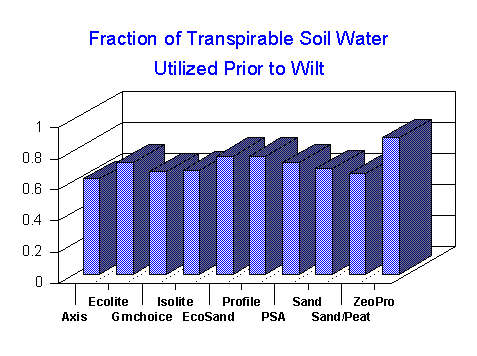
Water Retention/
Release Characteristics
Professor Grady L. Miller, University of Florida, conducted turfgrass experiments during 1997-1998 on the impacts of various amendments on turfgrass performance. A part of his experiments involved water use changes caused by the various amendments. His research findings can be found in HortScience 35(2):213-216.April2000. Quoting from the article:
"Modern golf greens are constructed using root-zone media consisting primarily of medium to course sand (0.25-1.00 mm). The highly permeable sands resist compaction and have adequate aeration, infiltration and percolation, but poor nutrient and water retention. During construction and maintenance, golf green soils are often amended to improve resiliency and nutrient and water retention (Beard, 1973). Decomposed peat is the organic material most commonly used in root-zone modification. Although organic amendments increase water and nutrient retention, they decompose with time. Thus, an amendment is needed that will increase water and nutrient holding capacity while remaining stab3l over time...The purpose of this research was to examine the effects of several soil amendments currently marketed for golf green use on transpiration of 'Tidwarf' bermudagrass during drought stress and their influence on drought stress avoidance."
Two experiments were conducted, one in the spring and one in the summer. In both experiments grass was established over a 6 week period in greenhouse pots by sprigging. The amendments were applied by core aerification. At twelve weeks after sprigging, water was withheld in the drought stress experiment to allow soil dehydration and observe grass response.
In both experiments, spring and summer, turfgrass grown in ZeoPro closed its stomata at a much smaller fraction of transpirable soil water (FTSW) point than did the turfgrass in the other amendments. Dr. Grady Miller states in his article: "The lower FTSW for stomatal closure means that the plant could extract additional soil water before stomatal closure, and thus would exhibit a comparatively higher transpiration rate for a longer period of time. This delayed closure of stomata would appear to be advantageous under drought conditions when stress is short and intermittent." The chart below shows the FTWS utilized prior to wilt for each of the amendments tested.
Dr. Miller goes on in his article to state: "This study demonstrates that turfgrass may perform differently when grown in various inorganic root-zone media. These data suggest that inorganic soil amendments can influence soil water content, which may ultimately influence the plant's response to drought stress...Even in the small volumes tested in this study, several amendments enhanced turf quality and improved moisture states in comparison with sand."
ZeoPro amended plots use water more efficiently
